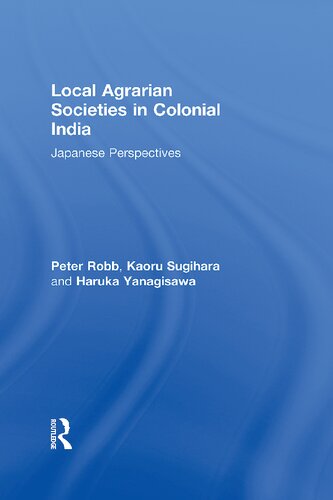

Most ebook files are in PDF format, so you can easily read them using various software such as Foxit Reader or directly on the Google Chrome browser.
Some ebook files are released by publishers in other formats such as .awz, .mobi, .epub, .fb2, etc. You may need to install specific software to read these formats on mobile/PC, such as Calibre.
Please read the tutorial at this link. https://ebooknice.com/page/post?id=faq
We offer FREE conversion to the popular formats you request; however, this may take some time. Therefore, right after payment, please email us, and we will try to provide the service as quickly as possible.
For some exceptional file formats or broken links (if any), please refrain from opening any disputes. Instead, email us first, and we will try to assist within a maximum of 6 hours.
EbookNice Team

Status:
Available4.7
22 reviews
ISBN 10: 1315026740
ISBN 13: 9781315026749
Author: Peter Robb, Kaoru Sugihara, Haruka Yanagisawa
The first systematic attempt to introduce a full range of Japanese scholarship on the agrarian history of British India to the English-language reader. Suggests the fundamental importance of an Asian comparative perspective for the understanding of Indian history.
1.1 Distinctive Aspects of Rural Production in India: The Colonial Period
II
III
IV
V
VI
Bibliography
1.2 Internal Forces of Change in Agriculture: India and Japan Compared
Introduction
Small farmers as forces of change
Socio-economic stratification and its consequences
Some policy implications
2 The Mirasi System and Local Society in Pre-Colonial South India
Introduction
Tax-free land, dues and the mirasi system
Emergence of a new formation and the decline of the mirasi system
South Indian society since colonial rule
References
3 The Peasantry of Northern Bengal in the Late Eighteenth Century1
I. Composition of the peasantry: analysis of some village statistics
II. The small local leaders
III. The management of the raiyati holdings
IV. Concluding remarks
4.1 Elements of Upward Mobility for Agricultural Labourers in Tamil Districts, 1865-1925
Introduction
Intensive cultivation and small scale farming
Emigration of depressed classes and their emancipation
Emigration of upper-caste members to urban jobs
The emergence of low-caste small farmers and the decrease in the number of large Brahman landowners
Conclusion
4.2 A Comparison with the Japanese Experience
Introduction
Similarities
Differences
Conclusion
5 Regional Pattern of Land Transfer in Late Colonial Bengal
II
III
IV
V
6.1 Famines, Epidemics and Mortality in Northern India, 1870-1921
Introduction
Famine and epidemic malaria: the case of 1877-78
Famine and epidemic malaria: other cases
Famine and other epidemics
Conclusion
6.2 Famines and Epidemics: A Comparison between India and Japan
II
III
IV
7.1 Technology and Labour Absorption in the Indigenous Indian Sugar Industry: An Analysis of Appropriate Technology
Introduction
II. The market competitiveness of the modern sugar industry
III. The indigenous sugar industry—technological progress and market competitiveness
IV. Labour absorption in the indigenous sugar industry
V. Concluding remarks
7.2 Technology of the Indian Sugar Industry From an International Perspective
I. The modern sugar industry
II. The Indian indigenous sugar industry compared with Asian cases
8 Situating the Malabar Tenancy Act, 1930
Introduction
Categories of the janmis and the kudiyans
Janmis' landed property and its management
The janmis and the revenue administration
The problem of evictions
Profits of tenants (kudiyans)
The agrarian problem and the marumakkattayam system
The marumakkattayam reform movements
agrarian colonies
colonial agrarian
colonial agrarian policies class 8 bookstawa
agrarian structure of colonial india
3 colonial sectors
agrarian society pdf
Tags: Peter Robb, Kaoru Sugihara, Haruka Yanagisawa, Agrarian, Societies